Table of Contents
Free Radicals: The Hidden Enemy
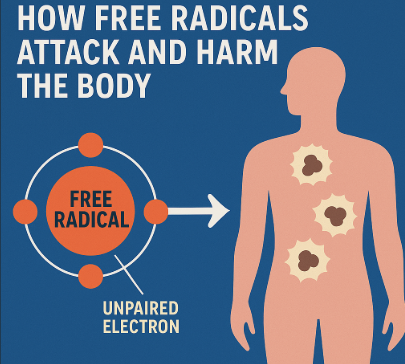
Free radicals are unstable molecules. They’re missing an electron—and like anything incomplete, they’re desperate to steal from others.They attack healthy cells. Left unchecked, they trigger inflammation, weaken immunity, and accelerate aging.
Free radicals… they’re the silent troublemakers that sneak in when your body is under stress—physically, mentally, or environmentally. You can’t see them, you can’t feel them immediately, but they quietly chip away at your health, cell by cell.
If free radicals don’t get antioxidants… they wreak silent havoc in your body. It’s like leaving a fire unattended in a forest—what starts as a spark soon becomes destruction.
🧬 Here’s What Happens When Free Radicals Run Wild:
⚠️ 1. They Steal From Your Cells
Free radicals are unstable—they’re missing an electron. To feel whole again, they steal that missing piece from your healthy cells. But when they snatch an electron from a stable cell, they damage it. That cell now becomes unstable too… and the destructive chain reaction begins.
💔 2. They Attack Your DNA
Without enough antioxidants, free radicals can break into the very blueprint of your body—your DNA. Over time, this leads to mutations, which may grow silently into tumors or trigger genetic diseases. Imagine the very foundation of your being… slowly chipped away.
🧓 3. They Speed Up Aging
Wrinkles. Fatigue. Foggy memory. Joint pain. These aren’t just “old age” problems—they’re signs of oxidative stress. Free radicals age your cells from the inside out, making your skin sag, your bones ache, and your body feel older than it really is.
🧠 4. They Weaken Your Brain
Your brain is especially vulnerable. Free radicals damage neurons, affect blood flow, and are linked to Alzheimer’s, dementia, and depression. Without antioxidant support, even your memories are at risk.
💣 5. They Trigger Inflammation
Inflammation is your body’s way of crying out. And when free radicals overwhelm your system, it responds with pain, swelling, fatigue—chronic inflammation that refuses to go away. This paves the path for autoimmune diseases, diabetes, arthritis, and more.
🦠 6. They Invite Chronic Diseases
Cancer. Heart disease. Diabetes. These aren’t just random conditions—they’re often rooted in oxidative damage. When your body’s defense system lacks antioxidants, the internal war escalates… and your health becomes the casualty.
❤️🩹 Your Body Is Crying for Help
When you don’t give your body the antioxidants it needs, your cells start to suffer, your energy fades, and illness becomes more than just a risk—it becomes reality.
But there’s hope.
Because nature has a plan. In every berry, every green leaf, every herb and spice—there’s a silent protector: antioxidants. All you have to do is invite them in.
How Are Free Radicals Generated?
Free radicals are unstable molecules. They’re missing an electron—and like anything incomplete, they’re desperate to steal from others. This chaos begins with oxidation, a natural process that happens in your body every second.
But the real trouble? It starts when the balance breaks.
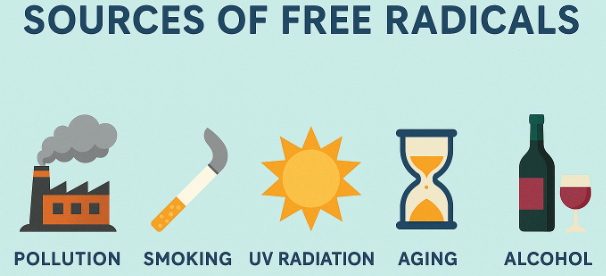
🔥 1. Normal Body Processes (The Inevitable Ones)
Even breathing produces free radicals. Your cells use oxygen to make energy. During this metabolism, some oxygen molecules split and form unstable atoms—free radicals. It’s normal. It’s natural. But it can turn dangerous when not balanced by antioxidants.
🧠 2. Stress and Emotional Turmoil
Did you know emotional stress can release free radicals too? When you’re anxious, angry, or overwhelmed, your body produces more cortisol and adrenaline. This hormonal storm can flood your system with oxidative stress—creating free radicals that slowly wear your immunity down.
🏭 3. Pollution and Toxins
Breathe in smoke, walk by a busy road, spray some chemical cleaners—and you’re already feeding the free radical frenzy. Our environment is flooded with toxins that our bodies weren’t designed to process every day. Air pollution, pesticides, heavy metals—they all spark free radical production.
🚬 4. Smoking and Alcohol
Every puff of a cigarette, every glass too many, loads your system with unstable molecules. These lifestyle habits strip your body’s natural defenses, letting free radicals run wild. It’s not just the lungs or liver that suffer—it’s every cell, every tissue, silently screaming for help.
🍟 5. Processed and Fried Foods
Hydrogenated oils, excessive sugar, artificial additives—foods made in factories, not farms, push your body into an inflammatory state. That inflammation creates—you guessed it—more free radicals. And when you eat like that day after day, your body can’t keep up.
☀️ 6. UV Radiation
Yes, sunlight is beautiful. It’s vital. But excessive, unprotected exposure triggers oxidative damage in your skin cells. That’s why too much sun ages you faster—free radicals start breaking down collagen and DNA without mercy.
💊 7. Certain Medications and Radiation Exposure
Even life-saving treatments like chemotherapy or X-rays produce free radicals. While necessary in many cases, these powerful interventions also lead to collateral damage on a cellular level.
🌿 What Are Antioxidants?
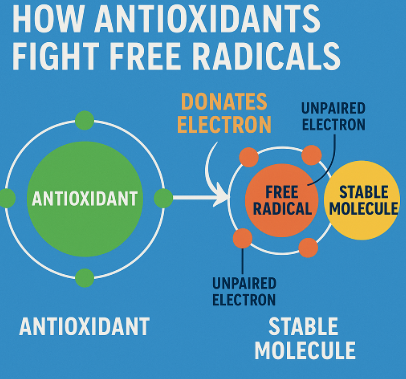
Antioxidants neutralize free radicals by donating one of their own electrons, effectively stabilizing the unstable molecules without becoming unstable themselves. Free radicals are highly reactive because they have unpaired electrons, which they steal from healthy cells—causing damage to DNA, proteins, and cell membranes. Antioxidants, such as vitamins C and E, polyphenols, and flavonoids, interrupt this chain reaction by safely pairing with the free radical’s unpaired electron. This stabilizes the molecule and prevents further cellular harm. Think of antioxidants as peacekeepers—sacrificing themselves to protect your body’s cells from oxidative stress and long-term damage.
Your Body’s Internal Defense System
Your body does make some antioxidants. But with the chaos of modern life—poor sleep, toxic air, stress—you often need extra support from food. And when you give your body that support? It thrives.
Antioxidants are molecules that protect your body from damage. But they’re more than just a science term—they’re nature’s way of saying, “I’ve got your back.” They help you heal from the inside out, keeping your cells strong, your skin glowing, and your heart beating with purpose.
💔 Oxidative Stress
Oxidative stress occurs when there’s an imbalance between free radicals and antioxidants in your body. When free radicals outnumber antioxidants, they begin to damage cells, proteins, and DNA—contributing to aging and diseases like cancer, diabetes, and heart conditions.
🔍 Signs Your Body Needs More Antioxidants
- You get sick often
- You feel tired even after rest
- You look older than your age
- You have poor digestion or constant bloating
- Your skin lacks glow or breaks out easily
Fatigue, Anxiety, and That Feeling of “Not Being Yourself”
Ever feel drained for no reason? Foggy brain? Constantly catching colds? That’s not “just life.” That’s your body waving a red flag—saying it’s tired of the damage and crying out for healing.
When Your Body Starts to Whisper (or Scream)
First it whispers—skin breakouts, low energy, poor sleep. Ignore it long enough, and it starts to scream—chronic diseases, depression, or a heart that feels too heavy. Antioxidants help soothe the pain before it becomes unbearable.
🌟 Types of Antioxidants and Their Functions
Vitamin C – The Immunity Booster
Found in oranges, amla, strawberries, and bell peppers. It fights infections, heals wounds, and gives your skin that fresh, morning glow.
Vitamin E – The Skin Guardian
Nuts, seeds, and green leafy veggies. It’s like a gentle hand caressing your cells, protecting them from pollution and stress.
Beta-Carotene – The Eye and Lung Protector
Carrots, sweet potatoes, pumpkin—these colorful foods help keep your vision sharp and your lungs clean.
Selenium and Zinc – The Cellular Repair Crew
Brazil nuts, whole grains, legumes. These minerals work silently to repair damaged tissues and keep your immune system alert.
Flavonoids & Polyphenols – The Plant Warriors
Found in berries, tea, cocoa, and spices—these powerful compounds calm inflammation and balance blood sugar.
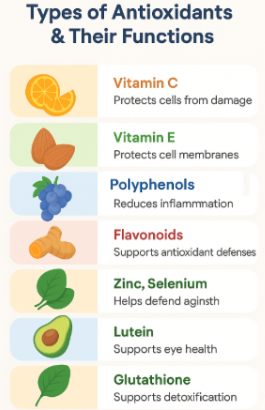
🍇 Food Sources Rich in Antioxidants
Fruits That Heal
- Berries (blueberries, strawberries, blackberries)
- Pomegranates
- Grapes
- Apples with skin
Vegetables That Revive
- Kale
- Spinach
- Beets
- Broccoli
- Red cabbage
Spices That Fight Inflammation
- Turmeric (with black pepper!)
- Cinnamon
- Ginger
- Clove
Other Power Foods
- Walnuts, almonds, flaxseeds
- Green tea
- Dark chocolate (yes, really—just keep it 70% or more!)
🥗 How to Add More Antioxidants to Your Day
Easy Meals and Snack Ideas
- Morning smoothie: berries, spinach, flax, banana
- Midday snack: nuts and dark chocolate
- Lunch: quinoa salad with beets and kale
- Dinner: turmeric lentil soup with sautéed broccoli
Start Your Day with a Healing Ritual
Begin each morning with warm lemon water and a fruit bowl. Your body will say thank you.
🧬 Lifestyle and Antioxidants: Why Your Choices Matter
Smoking, Pollution & Processed Foods: Enemies of Balance
If your body is constantly battling toxins, no amount of antioxidants can keep up. Cut back the bad, and let the good work its magic.
Can Supplements Replace Natural Foods?
They can help, but they’ll never replace the power of fresh, whole food. Nature wraps antioxidants with fiber, enzymes, and love—something no pill can recreate.
❤️ Antioxidants and Chronic Disease Prevention
Cancer
Antioxidants can neutralize the damage that may lead to cancerous changes in cells. They don’t cure—but they shield.
Heart Disease
They reduce blood pressure, cholesterol, and prevent artery damage.
Alzheimer’s and Cognitive Decline
Fewer free radicals mean sharper memory, better mood, and clearer focus.
Diabetes and Inflammation
They improve insulin sensitivity and reduce chronic pain and swelling.
🫶 Antioxidant-Rich Foods & Recipes in India: Healing Through Every Bite
India—land of spices, vibrant colors, and soulful meals. Our ancient kitchens have long held secrets of health and healing, passed down not just through scriptures but through love. In every home-cooked sabzi, every scoop of chutney, every spoon of haldi-doodh lies a story… a quiet promise of strength.
When you choose foods rich in antioxidants, you’re not just eating—you’re honoring your body, protecting your cells, and embracing the wisdom of your roots.
Let’s dive into some of India’s most powerful antioxidant-rich foods and recipes that heal from the inside out. 💛
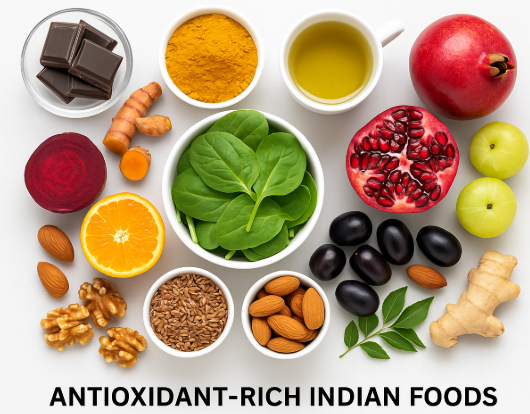
🌾 15 Indian Antioxidant-Rich Foods That Speak the Language of Wellness
- Amla (Indian Gooseberry) – One of the richest sources of Vitamin C, amla is a miracle fruit for immunity, skin, and hair.
- Turmeric (Haldi) – With curcumin as the star compound, haldi is nature’s anti-inflammatory gift.
- Tulsi (Holy Basil) – A sacred herb known for its adaptogenic and detoxifying properties.
- Spinach (Palak) – Loaded with vitamins A, C, and E, plus iron and fiber.
- Beetroot (Chukandar) – Bright, beautiful, and filled with nitrates and antioxidants.
- Pomegranate (Anar) – Jewel-like seeds that support heart health and protect against oxidative stress.
- Moringa (Drumstick leaves/Sahjan) – A superfood loaded with vitamins, minerals, and antioxidants.
- Berries (Jamun, Amla, Karvanda) – Local berries are rich in anthocyanins and flavonoids.
- Green Tea – Especially tulsi green tea, full of polyphenols.
- Cinnamon (Dalchini) – Improves blood sugar control and reduces inflammation.
- Dark Chocolate (Indian Cacao) – Go for natural, less processed versions.
- Flaxseeds (Alsi) – A rich plant source of Omega-3 and lignans.
- Nuts (Almonds, Walnuts) – Vitamin E-packed and heart-healthy.
- Ginger (Adrak) – Heals the gut and fights cell damage.
- Curry Leaves (Kadi Patta) – Rich in beta-carotene, iron, and antioxidants.
🍛 7 Antioxidant-Rich Indian Recipes That Comfort & Heal
1. Amla Chutney – The Immunity Punch
Ingredients: Fresh amla, green chilies, coriander leaves, ginger, salt, a touch of jaggery
Why It Heals: Vitamin C, flavonoids, gut-loving properties
Emotional Touch: It’s like your grandmother’s hug—spicy, tangy, and healing.
2. Turmeric Milk (Haldi Doodh) – Your Bedtime Healer
Ingredients: Organic turmeric, a pinch of black pepper, milk (or plant-based), jaggery or honey
Why It Heals: Curcumin, antioxidants, good sleep
Emotional Touch: A cup of comfort, especially on days when your soul feels heavy.
3. Beetroot Raita – Cooling, Calming, Rejuvenating
Ingredients: Beetroot, curd, roasted cumin, salt
Why It Heals: Supports digestion, skin, and detox
Emotional Touch: Like a cool breeze on a hot day—this pink dish soothes inside out.
4. Moringa Dal – The Forgotten Superfood on Your Plate
Ingredients: Toor dal, fresh moringa leaves, turmeric, garlic
Why It Heals: High in vitamins A, C, iron, and protein
Emotional Touch: Earthy, humble, and soul-satisfying—this is health served with love.
5. Millet Khichdi – A Warm Bowl of Balance
Ingredients: Foxtail or barnyard millet or little millet, moong dal, carrots, spinach, turmeric, ghee
Why It Heals: Antioxidants, fiber, iron, complete nourishment
Emotional Touch: It’s a warm reminder that simplicity is power.
Find some delicious millet recipes here and foxtail millet recipes here.
6. Pomegranate Mint Salad – A Burst of Life in Every Bite
Ingredients: Anar pearls, mint, lemon juice, rock salt, chaat masala
Why It Heals: Antioxidants, digestive enzymes, freshness
Emotional Touch: A celebration in a bowl—sweet, tangy, and alive.
7. Tulsi Ginger Kadha – Your Inner Warrior’s Potion
Ingredients: Tulsi leaves, ginger, black pepper, cinnamon, jaggery
Why It Heals: Immunity, respiratory health, detox
Emotional Touch: Like a prayer in liquid form—warm, healing, and sacred.
🌞 Simple Habits to Add Antioxidants to Your Daily Routine
- Start your morning with warm lemon water + amla juice.
- Add turmeric to dals, curries, and soups.
- Sprinkle flaxseeds on your roti dough or chutney.
- Replace one chai with tulsi or ginger tea.
- Choose a fruit chaat or fresh anar over fried snacks.
- Use mustard oil or cold-pressed oils with native antioxidants for cooking.
- Snack on roasted almonds and dark cacao nibs.
- Replace refined grains with whole grains like millet.
⚖️ A Word of Caution: Balance is Key
Too Much of a Good Thing?
More isn’t always better. Overdosing on supplements like vitamin A or E can be harmful. Let food be your primary medicine.
🧘 Real Stories: Healing Through Antioxidant-Rich Living
People reversing inflammation. Parents healing their child’s eczema. Seniors regaining energy. These aren’t miracles—they’re the quiet result of choosing whole foods over fast fixes.
Indian Diet Plan for Eczema (Apollo Hospitals)
Apollo Hospitals outlines an anti-inflammatory diet tailored to Indian cuisine that uses antioxidant-rich foods—fruits, vegetables, omega‑3–rich fish, curd, oils—to soothe eczema and reduce flare‑ups link.
Video
Watch the video in Hindi –
🌈 Conclusion: Choosing Healing Over Harm
Your body speaks. It feels, breaks, heals, and remembers. Give it what it needs. Antioxidants are more than nutrients—they’re a daily act of love. A way to say, “I choose life. I choose healing.”
In a world full of toxins, let your plate be your protest. Let your food be your medicine. Let antioxidants whisper life back into your tired cells.
❓ FAQs
1. Are antioxidant supplements safe?
Natural food sources are always better. Supplements should only be used if prescribed by a healthcare provider.
2. Can I get enough antioxidants from food alone?
Absolutely! A colorful, plant-based diet can give you all the antioxidants you need.
3. How quickly do antioxidants show results?
It depends on your body, but many people feel more energetic, clearer, and healthier within a few weeks.
4. Are antioxidants good for skin and hair?
Yes! They reduce oxidative damage, which can lead to clearer skin and healthier, shinier hair.
5. Do children need antioxidants too?
Yes. A diet rich in fruits, vegetables, and whole foods helps growing bodies develop stronger immunity and brain function.
**Please don’t forget to leave a review.
🔗 Source & Reference Links
- Harvard Health – Foods that fight inflammation
Provides scientific insights into how antioxidant-rich foods like berries, leafy greens, nuts, and olive oil help prevent inflammation and chronic disease.
🔗 https://www.health.harvard.edu/staying-healthy/foods-that-fight-inflammation - Harvard School of Public Health – “What Are Antioxidants? (The Nutrition Source)” A trusted overview of key antioxidant nutrients—vitamins, carotenoids, minerals—and their food sources such as fruits, vegetables, nuts, seeds, and whole grains
If you missed our blog on Balanced Diet click here.
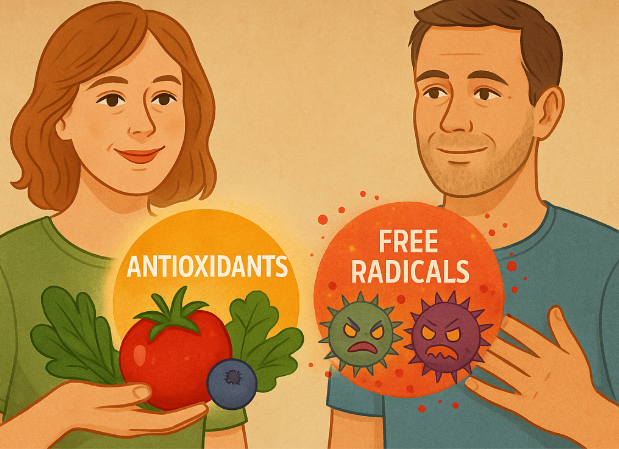
2 thoughts on “5 Types of Antioxidants & Food Sources: Nature’s Silent Protectors”